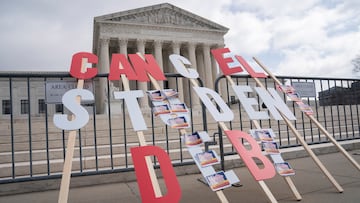FINANCE
How to alleviate your student loan debt if the Supreme Court overturns Biden’s forgiveness plan
President Biden’s highly anticipated plan for student loan debt forgiveness hangs in uncertainty, while borrowers explore other paths to ease their burdens.

Student loan debt has been ballooning over the past few decades with a collective total of almost $1.76 trillion currently. A survey in 2021, showed that 60 percent of millennials that don’t own a home, are being held back from doing so because of their student loan debt.
So, when President Joe Biden announced his plan for student loan debt forgiveness, following through on a campaign pledge, it was welcomed by many, but not all. The executive order to cancel up to $20,000 in federal student loan debt for qualified borrowers met quickly with legal challenges claiming that Biden had overstepped his authority. Two of those lawsuits put the program on pause and were fast tracked to be heard by the Supreme Court.
The long-awaited ruling by the Supreme Court is due to arrive on Friday morning. That has left many borrowers wondering what they can do to alleviate their student loan debt burden if the high court deems the program unconstitutional.
Student loan borrowers have time to prepare for the worst-case scenario
The good news for borrowers is that the moratorium on repaying student loans and interest accruing on them is still in place. The covid-era policy doesn’t expire until either 60 days have passed from the time the litigation around its forgiveness plan resolves, or failing that, at the end of August, whichever comes first.
So, those with student loan debt that were hoping to take advantage of the forgiveness program have time to prepare for whatever the outcome is. That way your financial situation won’t come unraveling, as the saying goes, “a stitch in time saves nine.”
How to alleviate your student loan debt if the Supreme Court overturns Biden’s forgiveness plan
The Biden administration has been working to overhaul student loan forgiveness programs that are already in place. “Student loans were never meant to be a life sentence, but it’s certainly felt that way for borrowers locked out of debt relief they’re eligible for,” said US Secretary of Education Miguel Cardona last year announcing changes his department was working on to speed up debt cancellations under existing programs.
Student-loan borrowers can take advantage of Public Service Loan Forgiveness (PSLF) programme. This programme forgives the remaining balance on your federal Direct Loans after you have made 120 qualifying payments, the equivalent of 10 years’ worth, while working full-time for a qualifying employer in public service or non-profit organisations.
There is also the potential option of Income-Driven Repayment plans. The Biden Administration announced that it was proposing new regulations that would amend the terms of the Revised Pay As You Earn (REPAYE). The proposed regulations would increase the amount of income protected from repayment from 150 percent of the Federal poverty guidelines to 225 percent. The amount that borrowers would be required to pay above the increased level of 225 percent would be half of the most generous IDR plan nowadays. Finally, the White House is seeking to reduce the amount of time until a remaining balance could be cancelled from 20 years for undergraduate loan debt and 25 years for graduate loan debt down to just 10 years.
The White House also announced proposed changes to shorten the time for debt to be forgiven under IDR plans to just 10 years of payments, even if those payments are for zero dollars per month, in some cases. The proposal could also cut payments in half by raising the threshold for income protected from repayment in addtion to stopping interest from accumulating if monthly payments are made.
One final, nuclear option would be to declare bankruptcy, but this would come at the expense of a downgraded credit rating for 7 to 10 years. The Biden administration announced updated guidance on how the government treats federal student loan debt in bankruptcy proceedings. Previously, this avenue was near to impossible to use, but will only apply to those who are experiencing “undue-hardship” because of their outstanding student loan debt.





